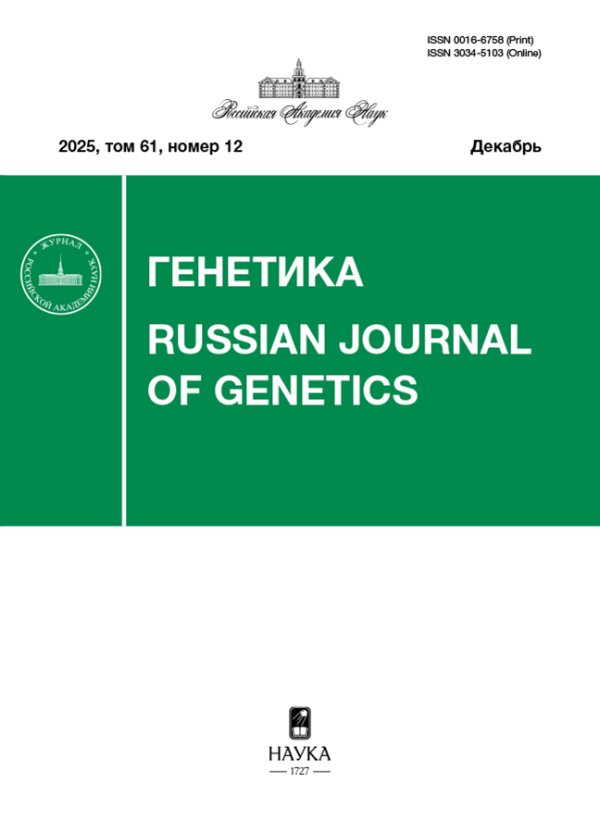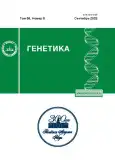Анализ мутаций генов автономного эмбрио- и эндоспермогенеза кукурузы
- Авторы: Моисеева Е.М.1, Фадеев В.В.1, Красова Ю.В.1, Чумаков М.И.1
-
Учреждения:
- Институт биохимии и физиологии растений и микроорганизмов, Федеральный исследовательский центр “Саратовский научный центр Российской академии наук”
- Выпуск: Том 59, № 9 (2023)
- Страницы: 1090-1093
- Раздел: КРАТКИЕ СООБЩЕНИЯ
- URL: https://journals.rcsi.science/0016-6758/article/view/134652
- DOI: https://doi.org/10.31857/S0016675823090084
- EDN: https://elibrary.ru/WURIET
- ID: 134652
Цитировать
Полный текст
Аннотация
Проведена сравнительная оценка мутаций генов гиногенеза и партеногенеза у различных линий кукурузы саратовской селекции. В частности секвенированы гены, контролирующие гиногенез (Zm_Pla1, Zm_CenH3, Zm_Dmp7) и взаимодействие мембран гамет (Zm_Gex2, Zm_Gcs1) у гаплоиндуцирующих (ЗМС-8, ЗМС-П) линий, и гены, предположительно связанные с автономным развитием эндосперма (Zm_Chr106, Zm_Hdt104 и Zm_Fie1) у партеногенетических (АТ-1, АТ-3, АТ-4) и обычных (КМ, ГПЛ-1) линий кукурузы саратовской селекции. С помощью методов биоинформатики проведено сравнение и выявлены изменения в нуклеотидных последовательностях исследованных генов у разных линий кукурузы. На основании данных секвенирования сделан вывод о возможности использования генов Zm_Pla1, Zm_Gex2 и Zm_Fie1 для генотипирования линий и гибридов кукурузы.
Об авторах
Е. М. Моисеева
Институт биохимии и физиологии растений и микроорганизмов, Федеральный исследовательский центр “Саратовский научный центр Российской академии наук”
Email: chumakov_m@ibppm.ru
Россия, 410049, Саратов
В. В. Фадеев
Институт биохимии и физиологии растений и микроорганизмов, Федеральный исследовательский центр “Саратовский научный центр Российской академии наук”
Email: chumakov_m@ibppm.ru
Россия, 410049, Саратов
Ю. В. Красова
Институт биохимии и физиологии растений и микроорганизмов, Федеральный исследовательский центр “Саратовский научный центр Российской академии наук”
Email: chumakov_m@ibppm.ru
Россия, 410049, Саратов
М. И. Чумаков
Институт биохимии и физиологии растений и микроорганизмов, Федеральный исследовательский центр “Саратовский научный центр Российской академии наук”
Автор, ответственный за переписку.
Email: chumakov_m@ibppm.ru
Россия, 410049, Саратов
Список литературы
- Чумаков М.И., Гусев Ю.С., Богатырева Н.В., Соколов А.Ю. Оценка рисков распространения генетически модифицированной кукурузы с пыльцой при выращивании с нетрансформированными сортами (обзор) // С-хоз. биология. 2019. Т. 54. № 3. С. 426–445. https://doi.org/10.15389/agrobiology.2019.3.426rus
- Тырнов В.С., Завалишина А.Н. Индукция высокой частоты возникновения матроклинных гаплоидов кукурузы // Докл. АН СССР. 1984. Т. 276. С. 735–738.
- Zavalishina A.N., Tyrnov V.S. Induction of matroclinical haploidy in maize in vivo // Reprod. Biol. and Plant Breeding. XIII EUCARPIA Congr. L 1992. P. 221–222.
- Еналеева Н.Х., Тырнов В.С., Селиванова Л.П., Завалишина А.Н. Одинарное оплодотворение и проблема гаплоиндукции у кукурузы // Докл. АН СССР. 1997. Т. 353. С. 405–407.
- Гуторова О.В., Апанасова Н.В., Юдакова О.И. Создание генетически маркированных линий кукурузы с наследуемым и индуцированным типами партеногенеза // Изв. Самарского науч. центра РАН. 2016. Т. 18. № 2. С. 341–344.
- Тырнов B.C., Еналеева Н.Х. Автономное развитие зародыша и эндосперма у кукурузы // Докл. АН СССР. 1983. Т. 272. № 3. С. 722–725.
- Enaleeva N.Kh., Tyrnov V.S. Cytological investigation of apomixis in AT-1 plants of corn // Maize Genet. Cooperation Newsletter. 1997. V. 71. P. 74–75.
- Апанасова Н.В., Титовец В.В. Цитоэмбриологическое изучение проявления апомиксиса у кукурузы линии АТ-3 после опыления // Бюлл. ботан. сада Саратовского гос. ун-та. 2003. № 2. С. 194–197.
- Kolesova A.Y., Tyrnov V.S. Embryological peculiarities of tetraploid parthenogenetic maize forms // Maize Genet. Cooperation Newsletter. 2012. V. 85. P. 65–66.
- Апанасова Н.В., Гуторова О.В., Юдакова О.И., Смолькина Ю.В. Особенности строения и развития женских генеративных структур у линий кукурузы с наследуемым и индуцированным типами партеногенеза // Изв. Самарского науч. центра РАН. 2017. Т. 19. № 2 (2). С. 216–219.
- Чумаков М.И., Мазилов С.И. Генетический контроль гиногенеза у кукурузы (обзор) // Генетика. 2022. Т. 58. № 4. С. 388–397. https://doi.org/10.31857/S001667582204004X
- Coe E.H. A line of maize with high haploid frequency // Am. Naturalist. 1959. V. 59. P. 381–382. https://doi.org/10.1086/282098
- Hu H., Schrag T.A., Peis R. et al. The genetic basis of haploid induction in maize identified with a novel genome-wide association method // Genetics. 2016. V. 202. P. 1267–1276. https://doi.org/10.1534/genetics.115.184234
- Garcia-Aguilar M., Michaud C., Leblanc O., Grimanelli D. Inactivation of a DNA methylation pathway in maize reproductive organs results in apomixis-like phenotypes // The Plant Cell. 2010. V. 22. P. 3249–3267. https://doi.org/10.1105/tpc.109.072181
- Mozgova I., Kohler C., Hennig L. Keeping the gate closed: Functions of the polycomb repressive complex PRC2 in development // The Plant J. 2015. V. 83. P. 121–132. https://doi.org/10.1111/tpj.12828
- Danilevskaya O.N., Hermon P., Hantke S. et al. Duplicated fie genes in maize: Expression pattern and imprinting suggest distinct functions // Plant Cell. 2003. V. 15. P. 425–438. https://doi.org/10.1105/tpc.006759
- Hermon P., Srilunchang K., Zou J. et al. Activation of the imprinted Polycomb group Fie1 gene in maize endosperm requires demethylation of the maternal allele // Plant Mol. Biol. 2007. V. 64. P. 387–395. https://doi.org/10.1007/s11103-007-9160-0
- Li S., Zhou B., Peng X. et al. OsFie2 plays an essential role in the regulation of rice vegetative and reproductive development // New Phytol. 2014. V. 201. P. 66–79. https://doi.org/10.1111/nph.12472
- Моисеева E.М., Гусев Ю.С., Гуторова О.В., Чумаков М.И. Анализ генов Hap2/Gcs1, Gex2 у линий кукурузы саратовской селекции // Генетика. 2023. Т. 59. № 3. С. 327–335. https://doi.org/10.31857/S0016675823030098
- Gilles L.M., Khaled A., Laffaire J.B. et al. Loss of pollen-specific phospholipase NOT LIKE DAD triggers gynogenesis in maize // EMBO J. 2017. https://doi.org/10.15252/embj.201796603
Дополнительные файлы










